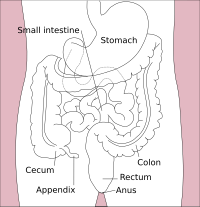
Back Slukderm Afrikaans Esofago AN مريء Arabic ܝܫܛܐ ARC РискӀи AV Mallq'a Aymara Qida borusu Azerbaijani مری AZB Kolongan BAN Стрававод чалавека Byelorussian
| Esophagus | |
|---|---|
 The digestive tract, with the esophagus marked in red | |
| Details | |
| Precursor | Foregut |
| System | Digestive system |
| Artery | Esophageal arteries |
| Vein | Esophageal veins |
| Nerve | Sympathetic trunk, vagus |
| Identifiers | |
| Latin | oesophagus |
| Greek | οἰσοφάγος |
| MeSH | D004947 |
| TA98 | A05.4.01.001 |
| TA2 | 2887 |
| FMA | 7131 |
| Anatomical terminology | |
 |
| Major parts of the |
| Gastrointestinal tract |
|---|

The esophagus (American English) or oesophagus (British English, see spelling differences; both /iːˈsɒfəɡəs, ɪ-/;[1] pl.: (o)esophagi or (o)esophaguses), colloquially known also as the food pipe, food tube, or gullet, is an organ in vertebrates through which food passes, aided by peristaltic contractions, from the pharynx to the stomach. The esophagus is a fibromuscular tube, about 25 cm (10 in) long in adults, that travels behind the trachea and heart, passes through the diaphragm, and empties into the uppermost region of the stomach. During swallowing, the epiglottis tilts backwards to prevent food from going down the larynx and lungs. The word oesophagus is from Ancient Greek οἰσοφάγος (oisophágos), from οἴσω (oísō), future form of φέρω (phérō, "I carry") + ἔφαγον (éphagon, "I ate").
The wall of the esophagus from the lumen outwards consists of mucosa, submucosa (connective tissue), layers of muscle fibers between layers of fibrous tissue, and an outer layer of connective tissue. The mucosa is a stratified squamous epithelium of around three layers of squamous cells, which contrasts to the single layer of columnar cells of the stomach. The transition between these two types of epithelium is visible as a zig-zag line. Most of the muscle is smooth muscle although striated muscle predominates in its upper third. It has two muscular rings or sphincters in its wall, one at the top and one at the bottom. The lower sphincter helps to prevent reflux of acidic stomach content. The esophagus has a rich blood supply and venous drainage. Its smooth muscle is innervated by involuntary nerves (sympathetic nerves via the sympathetic trunk and parasympathetic nerves via the vagus nerve) and in addition voluntary nerves (lower motor neurons) which are carried in the vagus nerve to innervate its striated muscle.
The esophagus passes through the thoracic cavity into the diaphragm into the stomach.
The esophagus may be affected by gastric reflux, cancer, prominent dilated blood vessels called varices that can bleed heavily, tears, constrictions, and disorders of motility. Diseases may cause difficulty swallowing (dysphagia), painful swallowing (odynophagia), chest pain, or cause no symptoms at all. Clinical investigations include X-rays when swallowing barium sulfate, endoscopy, and CT scans. Surgically, the esophagus is difficult to access in part due to its position between critical organs and directly between the sternum and spinal column.[2]
- ^ Wells, John C. (2008). Longman Pronunciation Dictionary (3rd ed.). Longman. ISBN 978-1-4058-8118-0.
- ^ Jacobo, Julia (24 November 2016). "Thanksgiving Tales From the Emergency Room". ABC News.
© MMXXIII Rich X Search. We shall prevail. All rights reserved. Rich X Search